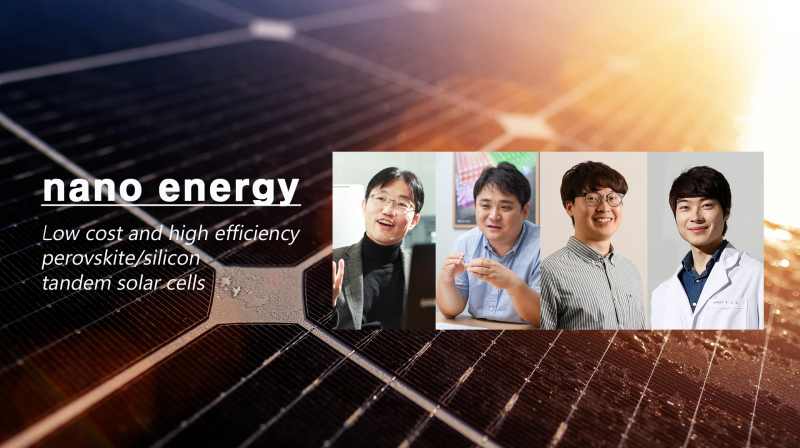In quest of higher efficiency, a major breakthrough has been made in silicon (Si) solar cell technology. Known as Tandem, this technology is aimed at overcoming the theoretical efficiency limit of Si solar cells by adding perovskite solar cells (PSCs) to Si solar cells. A joint research team, affiliated with UNIST challenged themselves with developing tandem solar cells for the first time, thus received much attention for achieving 21.19% efficiency.
This breakthrough has been carried out by Professor Kyoung Jin Choi and Professor Myoung Hoon Hoon in the School of Materials Science and Engineering at UNIST in collaboration with SHINSUNG E&G. In the present study, the research team proposed a new method for optimizing the design of low-cost and high-efficiency monolithic tandem cells based on p-type homojunction Si cells by realizing lossless current matching by simultaneously controlling the band gap energy and thickness of the perovskite film.
Silicon solar cell technology, which currently occupies most of the solar industry, has reached its limits in both efficiency and lowering manufacturing costs. The efficiency of Si solar cell has reached 26.6% (n-type, Heterojunction Back contact structure), which almost approached the 29% limit efficiency. And the cost also dropped to $ 0.16 per 1 watt (PERC solar cell).
“Due to the Chinese impacts on price-driven solar power energy, the solar power industry is starting the so-called game of chicken. Besides, prices have fallen steadily, thus threatening the break-even point,” says Professor Choi. “In order to survive in the future, domestic solar power companies need to innovate solar cell efficiency.
Shown above is a perovskite/silicon tandem solar cell, developed at UNIST.
Among many other alternatives, Perovskite/Si Tandem solar cells are considered to be the most effective method to solve the both efficiency limit and unit cost problem by bypassing the technical limit of current Si solar cells. This is because low-cost and high-efficiency solar cells can be manufactured by adding the merits of perovskite solar cells, while using the existing Si solar cell manufacturing processes.
Solar cells are devices in which the semiconductor that absorbs sunlight produces electricity. Since the range of sunlight that can be absorbed by each substance differs, there is a limitation in increasing the efficiency by using only a single substance.
“In a single junction solar cell, the range of absorption of sunlight is fixed, and there is a problem that sunlight of other regions is transmitted or is wasted as heat energy,” says Chan Ul Kim in the Combined M.S/Ph.D. of Materials Science and Engineering at UNIST, the first author of this study. “A multi-junction solar cell can minimize the energy dissipated or transmitted through a tandem structure that vertically stacks two or more optically-absorbing semiconductors complementary to each other.”
(Left) Schematic cross-sectional image of a fully planar monolithic perovskite/Si tandem device. (Right) J-V curve and maximum power point tracking characteristics (inset) of the best-performing monolithic perovskite/Si tandem devices.
There existed tandem cells based on semiconductors, using gallium (Gs) and arsenic (As). Yet, it has been difficult to commercialize it with expensive materials and processing equipment.
In this study, Si solar cell (p-Si Al-BSF Solar Cell), which occupies the mainstream of the solar cell market and has the lowest manufacturing cost, is utilized at the bottom. At the top, a highly efficient perovskite solar cell was built. As a result, the efficiency of the newly-developed low-cost, high-efficiency tandem solar cell had a significantly increased efficiency of 21.19% in the same tandem structure, thus setting the world-record.
“In the photovoltaic industry, it is necessary to acquire core source technology and to survive by having international competitiveness,” says Professor Choi. “We believe that this approach opens up a pathway for the commercialization of perovskite solar cells with industry-standard monocrystalline Si solar cells as highly efficient monolithic tandem devices.”
The findings of this study has been published in the March 2019 issue of Nano Energy, a prestigious journal in the field of Energy. It has been supported by the Korea Institute of Energy Technology Evaluation and Planning(KETEP) and the Korean Ministry of Trade, Industry & Energy (MOTIE).
Journal Reference
Chan Ul Kim et al., “Optimization of device design for low cost and high efficiency planar monolithic perovskite/silicon tandem solar cells,” Nano Energy, (2019).
















